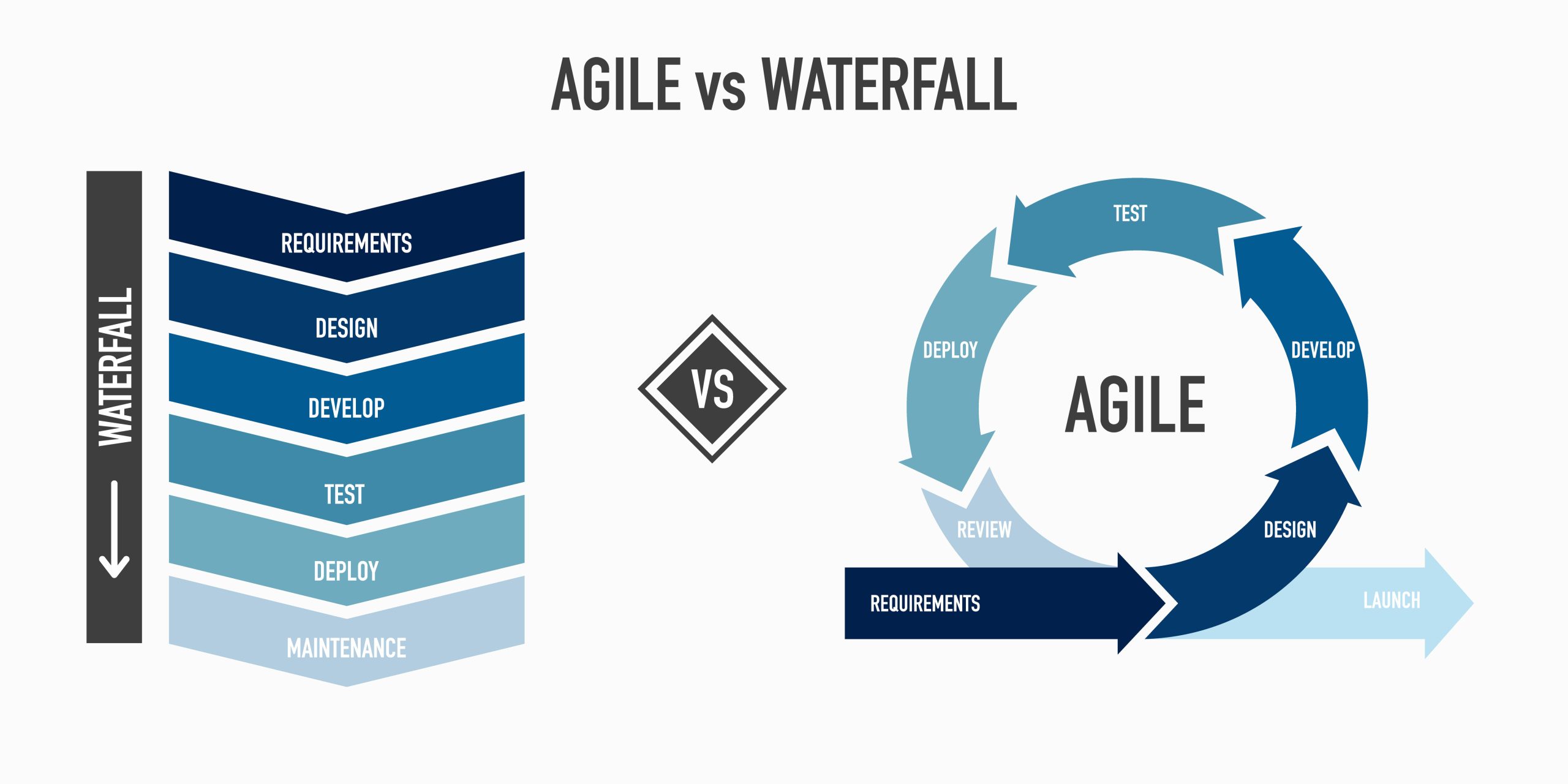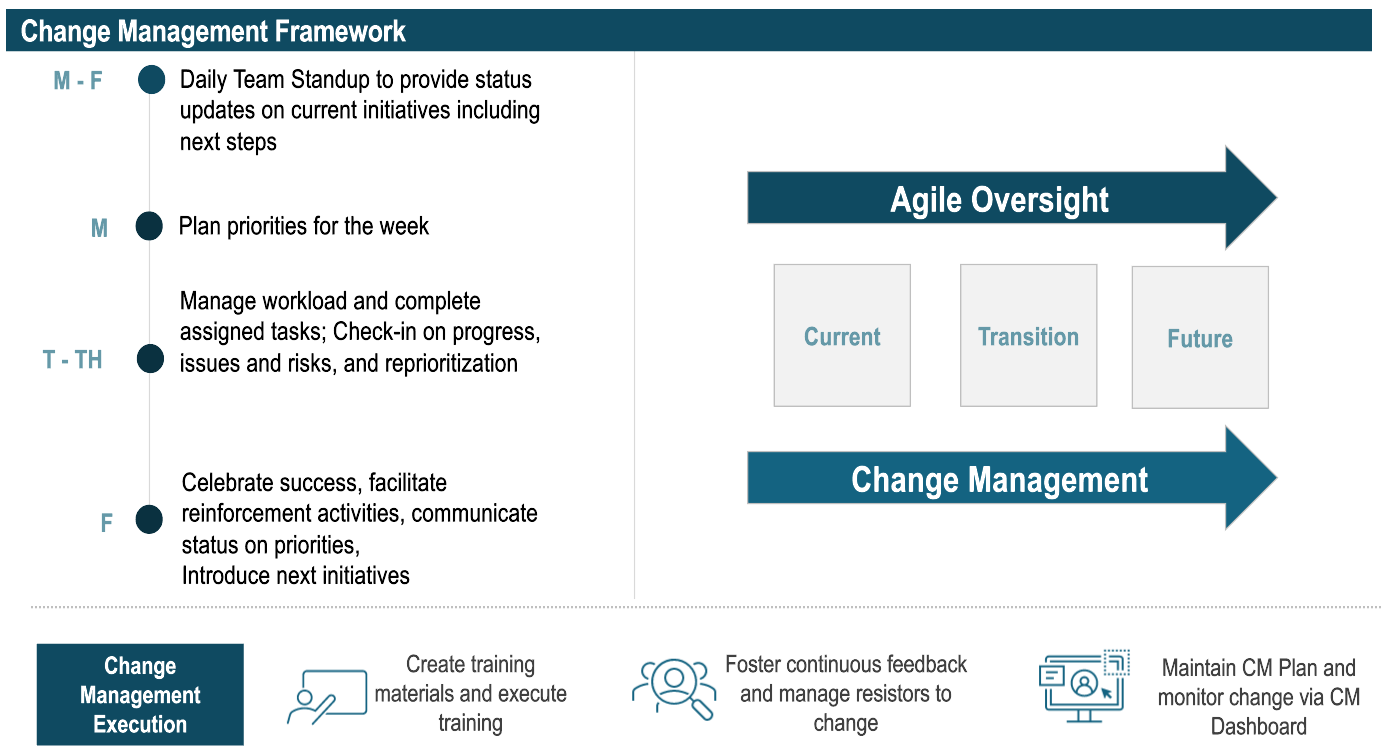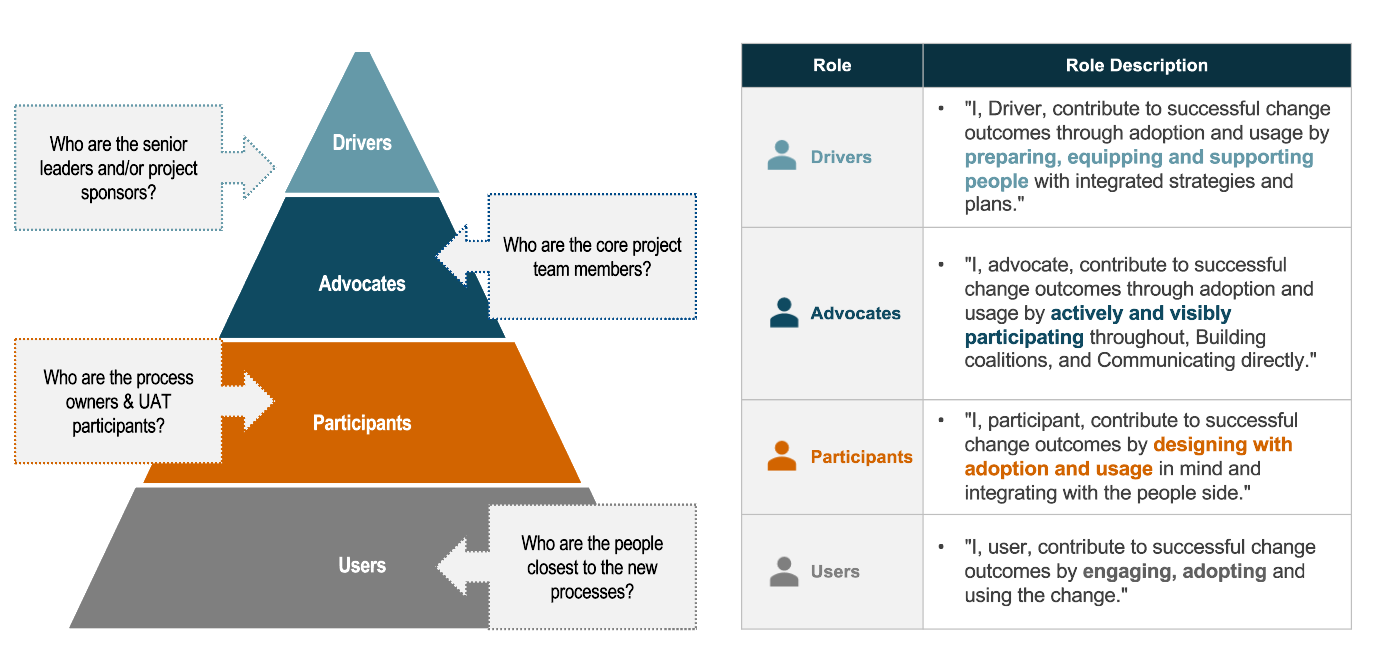It’s estimated that agile teams are 25% more productive and 50% faster than non-agile teams. These advantages are of particular interest to change leaders.
Applying agile principles to change initiatives is especially conducive to projects that are complex and ambiguous. The agile framework already contains the guardrails, triggers, and protocols for bringing clarity, accountability, and efficiency to projects that can be winding and time-intensive.
That’s why agile adoption is permeating new areas of business beyond software development. It’s now utilized in Internal Audit, operating model design, and other ambitious transformation efforts.
What Is Agile Change Management?
Agile change management is the practice of aligning agile methodology to change management processes. Using the tools, roles, methods, nomenclature, and goals of agile, organizations can generate faster, higher return on investment during a change initiative, such as a systems implementation, digital transformation, reorg, or policy update.

Core Benefits of Agile Change Management
The benefits derived from agile methodology carry over to change management processes as well. Iterating, delivering, and communicating faster and more effectively – axioms of agile – enable change leaders to approach the project with a proven framework.
The agile framework is useful in its ability to align stakeholders in their mission, language, and workflows, ensuring all parties work cohesively and methodically. By doing so, agile principles can drive meaningful benefits to the organizational change management process and the wider transformation at large, such as:
Speed to Market
Successive sprints and sprint reviews ensure progress doesn’t die on the vine. Tasks are delivered quickly and reviewed for quality assurance following standardized benchmarks.
Scalability
Multiple workstreams co-exist, allowing progress to be made on concurrent fronts at all times rather than waiting for delivery handoffs.
Prioritization
Using a Kanban board to visualize project backlogs and priority tasks, all stakeholders are aware of what’s coming next. Tasks are continuously re-prioritized by the Product Owner to ensure the most valuable task is completed in order.

Risk Management
With multiple roles and levels of authority involved in agile, stakeholders can foresee and flag risk rapidly. Daily scrums also empower staff to provide status updates and blockers to progress. Agile provides a forum and a mechanism to root out risk in any form.
Communication
Using daily scrums, visualization tools, and a centralized messaging platform, stakeholders are better informed of the past, current, and future workings of the project. With optimal communication occurring inside the core project team, updates can be messaged externally to the rest of the company more efficiently as well. The data is always on hand, and the next step is always clear, making status updates easy to procure and amplify.
Progress Reporting
The agile team is apprised of progress at all times with the ability to track all user stories, project roadmaps, and release planning in one project management software or agile board. Daily scrums can supplement status checks in case there’s still opacity around next steps or timelines.
Continuous Improvement
Built into agile project management are recurring reviews and retrospectives. This is a time to reflect on the previous sprint, optimize workflows, prioritize remaining backlog, and fine-tune the change request accordingly. Though changing requirements even late in the process are typically curve balls for non-agile waterfall teams, they are to be expected in an agile environment. The Product Owner can simply create a new user story for submission in the next sprint.
How and Where to Deploy Agile Methodology in Change Management
The primary motivating factors behind agile adoption are:
- Productivity.
- Accountability.
- Collaboration.
- Prioritization.
- Feedback.
While these characteristics are conceptually ideal for any project, the agile mindset isn’t necessarily suited for a change management activity that has predictable, repeatable, standardized steps. Agile is iterative and always in motion – it excels when creativity, collaboration, and flexibility are necessary as opposed to just following rote, fixed project plans.
Traditional project management leverages clearly defined steps and may not require quick delivery. Agile may not compute as designed in this environment.
However, agile has numerous applications for projects that require constant contact, fast delivery in intervals, regular communication with end users/reviewers, and multiple, evolving inputs.
When evaluating existing change management frameworks, there are several agile transformations that teams can make even if they opt not to fully embrace and implement textbook agile. Below are avenues to deploy agile that commonly prove to be useful:
Oversight
The agile method keeps change initiatives moving at all times. There aren’t multi-week gaps in progress or delays due to misalignment: A new update, functionality, or feature is shipped several times a month.

This is accomplished via oversight and execution from a Scrum Master and Product Owner. While organizations don’t have to mirror these titles or responsibilities, the impetus behind strong oversight remains. Whether it’s a change management Center of Excellence (CoE), an appointed change manager, or some type of agile change agent, some individual or small group of individuals must be driving the process forward in the face of resistance and blockers.
They must also ensure quality, employee motivation, and end user satisfaction. An agile approach to oversight can strategically facilitate change execution.
Roles
Within change management of any kind, some voices are louder than others. Striking the right balance, though, is not easy. For an implementation or policy update that impacts several or all functional areas, department heads must understand that their voice is indeed heard but not to the detriment of other departments’ concerns.
So who gets to be involved in change management? How large should the project team be? Who’s a decision-maker versus an influencer versus a participant?
Agile’s defined roles cut through this ambiguity.
- Scrum Master.
- Product Owner.
- Team Members.
- Stakeholders.
A similar hierarchy and division of labor can be leveraged in change management, as illustrated in the graphic below:

With dedicated roles, role descriptions, and responsibilities within the change management framework, it’s easier to hold all parties accountable for the shape, pace, and impact change will inevitably have on the business.
Shifting Priorities
Because change can often be circuitous, bumpy, and urgent, a confluence of demands must be met at all times. Managing complex change at scale means embracing a design thinking that champions iteration and flexibility.
Over the course of several months or years, shifting priorities will surface repeatedly. The agile process is specifically designed to ingest, systematize, and execute new priorities.
For organizations that know in advance that they have a long transformation ahead of them with diverging opinions and arduous buy-in processes, agile development can be a fit-for-purpose solution during the change management obstacles soon to come.
Dashboards
You can only manage what you can measure. Agile’s visualization and alignment capabilities make it ideal for teams moving fast across concurrent workstreams. A traditional Kanban board is the starting point for disseminating priorities, user stories, and timelines. With everyone looking at the same dashboard, it’s easier to check progress, manage workloads, move assigned tasks to completion, and monitor risk.
Because change will be communicated through multiple mediums, having a centralized place where core project work is stationed is key to helping change leaders stay on message when communicating externally.
With thousands of relevant project management tools available, this is perhaps the lowest-hanging fruit for organizations inching toward agile transformation at a suitable pace.
Removing Blockers
If nothing else, having a trigger mechanism and a dedicated forum to remove blockers, celebrate success, and facilitate reinforcement activities are incredibly beneficial.
Enduring delays with no immediate remediation is one of the primary reasons change efforts grind to a halt. The leader may not even know an issue exists, much less identify a solution and operationalize it effectively. In agile, it’s the Scrum Master’s job to specifically isolate blockers and clear them from each individual’s project work.
The Scrum Master is a powerful counterweight against inertia. At no point should team members be sitting on their hands uncertain how to proceed – the path forward must be clear for everyone. The ability to quickly overcome expected and unexpected obstacles helps expedite change and generate team morale that endures long after change has been implemented.
Transformation brings to light all inefficiencies inherent in the organization. It’s the change management team’s job to understand those challenges, iterate past them, and execute a plan for a better, more-efficient future state.
For expert support from top change management leaders, contact CrossCountry Consulting.